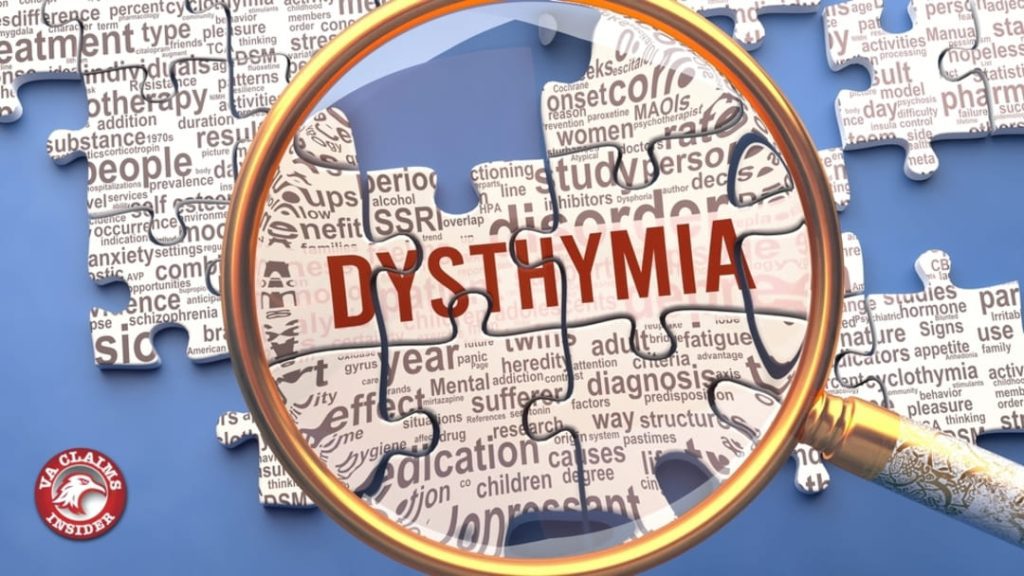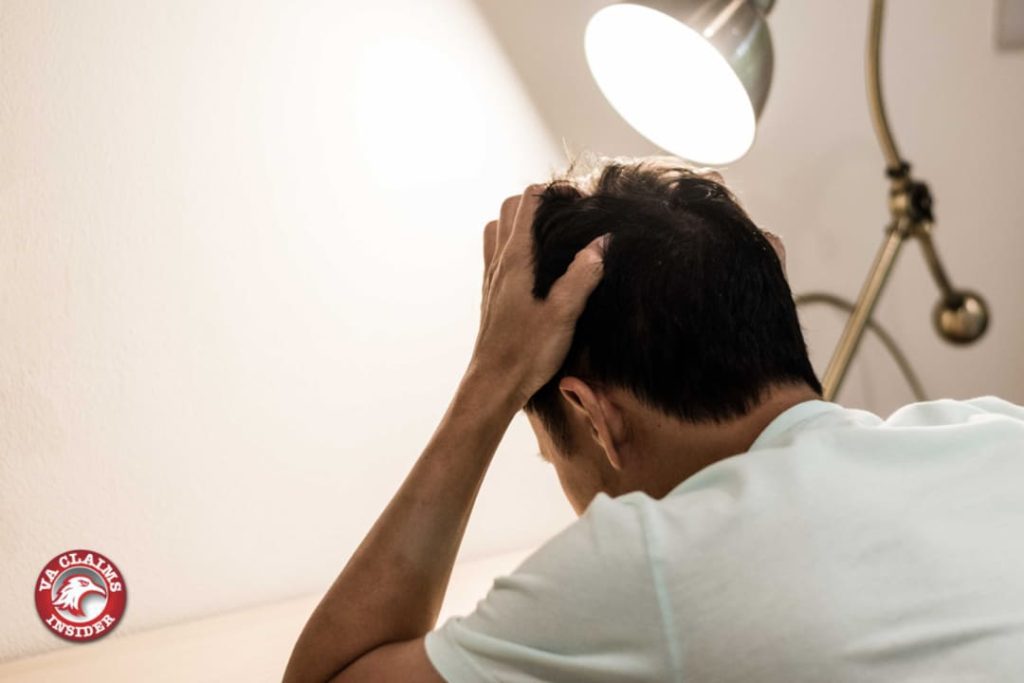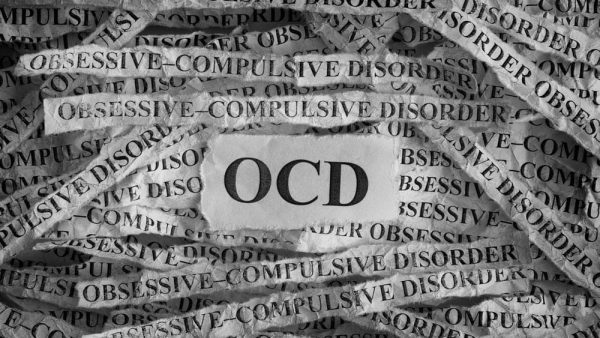Looking for Expert-Level VA Claim Answers?📱Call Us Now! 737-295-2226
Looking for how to get a dysthymia VA rating? You’ve come to the right place.
Dysthymia is a form of depression, a mental health disorder that can affect veterans due to the nature of their jobs. You may be entitled to VA disability benefits and compensation if your condition is linked to your military service.
This guide will examine:
- Symptoms of dysthymia
- Dysthymia VA ratings (& the dysthymia VA rating chart)
- How to prove service connection & much more!
Let’s dive in!
Table of Contents
Summary of Key Points
-
The VA rates dysthymia under the § 4.130 Schedule of ratings—Mental disorders, specifically under Diagnostic Code (DC) 9433.
-
Dysthymia VA ratings range from 0% to 100%, with breaks at 10%, 30%, 50%, and 70%.
-
Dysthymia is also known as persistent depressive disorder, with symptoms like insomnia, poor appetite, and fatigue.

Dysthymia in Veterans
Dysthymia, or persistent depressive disorder, is a milder but longer-lasting form of depression. Generally, symptoms come and go with varying intensity.
Persistent depressive disorder, as defined by the Diagnostic and Statistical Manual of Mental Disorders, is as follows:
- The patient must have been depressed for at least two years.
- For children or adolescents, the mood can be irritable instead of depressed, and the time requirement is one year.
- For both groups, symptoms cannot be absent for more than two months.
In addition to depressed or irritable mood, at least TWO of the following symptoms must be present.
- Poor appetite or overeating
- Insomnia or hypersomnia
- Low energy or fatigue
- Low self-esteem
- Poor concentration or decision-making
- Hopelessness
It’s vital you receive medical attention if these symptoms sound familiar. One study found that veterans diagnosed with dysthymia or depression were twice as likely to develop incident dementia compared to those with no dysthymia or depression.

Dysthymia VA Ratings
Dysthymia VA ratings range from 0% to 100% with breaks at 10%, 30%, 50%, and 70% under DC 9433, § 4.130 Schedule of ratings—Mental disorders.
Your dysthymia VA rating will depend significantly on your occupational and social impairment.
Dysthymia VA Rating Chart
| General Rating Formula for Mental Disorders | VA Rating |
| Total occupational and social impairment, due to such symptoms as: gross impairment in thought processes or communication; persistent delusions or hallucinations; grossly inappropriate behavior; persistent danger of hurting self or others; intermittent inability to perform activities of daily living (including maintenance of minimal personal hygiene); disorientation to time or place; memory loss for names of close relatives, own occupation, or own name. | 100% |
| Occupational and social impairment, with deficiencies in most areas, such as work, school, family relations, judgment, thinking, or mood, due to such symptoms as: suicidal ideation; obsessional rituals which interfere with routine activities; speech intermittently illogical, obscure, or irrelevant; near-continuous panic or depression affecting the ability to function independently, appropriately and effectively; impaired impulse control (such as unprovoked irritability with periods of violence); spatial disorientation; neglect of personal appearance and hygiene; difficulty in adapting to stressful circumstances (including work or a worklike setting); inability to establish and maintain effective relationships. | 70% |
| Occupational and social impairment with reduced reliability and productivity due to such symptoms as: flattened affect; circumstantial, circumlocutory, or stereotyped speech; panic attacks more than once a week; difficulty in understanding complex commands; impairment of short- and long-term memory (e.g., retention of only highly learned material, forgetting to complete tasks); impaired judgment; impaired abstract thinking; disturbances of motivation and mood; difficulty in establishing and maintaining effective work and social relationships. | 50% |
| Occupational and social impairment with occasional decrease in work efficiency and intermittent periods of inability to perform occupational tasks (although generally functioning satisfactorily, with routine behavior, self-care, and conversation normal), due to such symptoms as: depressed mood, anxiety, suspiciousness, panic attacks (weekly or less often), chronic sleep impairment, mild memory loss (such as forgetting names, directions, recent events). | 30% |
| Occupational and social impairment due to mild or transient symptoms which decrease work efficiency and ability to perform occupational tasks only during periods of significant stress, or symptoms controlled by continuous medication. | 10% |
| A mental condition has been formally diagnosed, but symptoms are not severe enough either to interfere with occupational and social functioning or to require continuous medication. | 0% |
How to Get VA Disability for Dysthymia
To qualify for a dysthymia VA rating, you must provide the following information:
- A current diagnosis of dysthymia
- An in-service event, injury, or illness that caused or aggravated the disability;
- A medical link (or nexus) between your condition and the incident.
See Also: How to Prove Service-Connected Disability
How to File a VA Claim for Dysthymia
The easiest way to file a VA claim for dysthymia is online, but you can also submit your application by mail, fax, or in person at a local regional VA office.
See More: How to File A VA Claim Online
VA Secondary Conditions to Dysthymia
It’s common for one condition to cause or aggravate another, which the VA refers to as a secondary condition.
The following are common secondary conditions to dysthymia:
- Migraines
- Sleep Apnea
- Gastroesophageal reflux disease (GERD)
- Irritable bowel syndrome (IBS)
- Erectile dysfunction (ED)
You must have the following to service connect secondary conditions to dysthymia:
- A current medical diagnosis of the secondary disability condition you’re attempting to link to dysthymia AND
- A current service-connected primary disability (e.g., your current dysthymia VA rating) AND
- Medical nexus evidence establishing a connection between the service-connected dysthymia and the current disability you’re trying to connect
Dysthymia and TDIU
If your service-connected dysthymia prevents you from keeping substantially gainful employment, you may qualify for Total Disability Based on Individual Unemployability (TDIU).
TDIU allows you to receive a 100% VA rating without having a disability rated at 100%.
In addition to being unable to maintain work, to be eligible for TDIU, you also must have:
- At least 1 service-connected disability rated at 60% or more disabling OR,
- 2 or more service-connected disabilities, with at least 1 rated at 40% or more disabling and a combined rating of 70% or more,
- RELATED: How to Win Your VA TDIU Claim
NEED MORE ASSISTANCE? We’ve Got Your SIX.
Most veterans are underrated for their disabilities and, therefore, not getting their due compensation. At VA Claims Insider, we guide you and take control of the claims process so you may get the rating and compensation you’re owed by law. If you’ve filed your VA disability claim and have been denied or have received a low rating—or you’re unsure how to get started—reach out to us!
Our process takes the guesswork out of filing a VA disability claim and supports you in building a fully developed claim (FDC)—so you may increase your rating FAST! Take advantage of a VA Claim Discovery Call. Learn what you’ve been missing—so you can FINALLY get the disability rating and compensation YOU DESERVE!
FAQs
Do I need a C&P exam for a dysthymia VA rating?
Generally, the VA requires you to attend a C&P exam to better assess the severity of your condition. Answering questions about a mental health condition can be challenging, but it’s important to be honest to ensure you receive the VA disability rating you deserve.
RELATED: How Do I Know if My C&P Exam Went Well?
What is the highest VA rating for dysthymia?
The highest dysthymia VA rating is 100%; however, dysthymia VA ratings range from 0% to 100%, with breaks at 10%, 30%, 50%, and 70%.
What is the diagnostic code for dysthymia?
A dysthymia VA rating falls under DC 9433.
Author

Kelly Olone
Kelly Olone is a military spouse who earned her degree in Psychology from Florida International University. After working in the non-profit sector for several years, she turned to her passion for writing. She aims to contribute to a better understanding of the valuable benefits that veterans deserve. As a mom, Kelly navigates the delicate balance between deadlines and bedtime stories with finesse.


